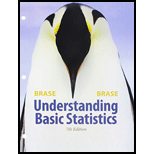
Concept explainers
Basic Computation: Testing
(a) Compute the pooled probability of success for the two experiments.
(b) Check Requirements What distribution does the sample test statistic follow? Explain.
(c) State the hypotheses.
(d) Compute
(c) Find the P-value of the sample test statistic.
(f) Conclude the test.
(g) Interpret the results.
(a)
To find: The pooled probability of success for the two experiments.
Answer to Problem 6P
Solution: The pooled probability of success for the two experiments is
Explanation of Solution
Calculation: Using,
Now, the pooled probability of success is calculated as follows:
The pooled probability of success is 0.36.
Now the value of the
The pooled probability of failure is 0.64.
(b)
Whether we should use normal distribution or not.
Answer to Problem 6P
Solution: The sample distribution follows standard normal distribution.
Explanation of Solution
The number of binomial trials is large enough that each of the products
(c)
The null and alternate hypothesis.
Answer to Problem 6P
Solution: The hypotheses are
Explanation of Solution
Since, we want to conduct a test of the claim that the probability of success for the second binomial experiment is greater than that for the first. Therefore the null hypothesis is
(d)
To find: The difference of sample proportion
Answer to Problem 6P
Solution: The difference of sample proportion
Explanation of Solution
Calculation:
The difference of
Thus, the difference of sample proportion
The sample test statistic is calculated as follows:
Thus, the sample test statistic is - 2.2
(e)
To find: The P-value of the sample test statistic.
Answer to Problem 6P
Solution: The P-value of test statistic is approximately 0.0134.
Explanation of Solution
Calculation:
The P-value is calculated as follows:
Using table 3 from Appendix, we get
Thus the P-value of the sample test statistic is approximately 0.0134.
(f)
Whether we should reject or fail to reject the null hypothesis for a 5% level of significance.
Answer to Problem 6P
Solution: The
Explanation of Solution
The P-value is less than the level of significance (
(g)
Interpretation for the result.
Answer to Problem 6P
Solution: We have sufficient evidence in the favor of the claim that the probability of success for the second binomial is greater than that for the first.
Explanation of Solution
The P-value is less than the level of significance (
Want to see more full solutions like this?
Chapter 10 Solutions
Bundle: Understanding Basic Statistics, Loose-leaf Version, 7th + WebAssign Printed Access Card for Brase/Brase's Understanding Basic Statistics, ... for Peck's Statistics: Learning from Data
- Examine the Variables: Carefully review and note the names of all variables in the dataset. Examples of these variables include: Mileage (mpg) Number of Cylinders (cyl) Displacement (disp) Horsepower (hp) Research: Google to understand these variables. Statistical Analysis: Select mpg variable, and perform the following statistical tests. Once you are done with these tests using mpg variable, repeat the same with hp Mean Median First Quartile (Q1) Second Quartile (Q2) Third Quartile (Q3) Fourth Quartile (Q4) 10th Percentile 70th Percentile Skewness Kurtosis Document Your Results: In RStudio: Before running each statistical test, provide a heading in the format shown at the bottom. “# Mean of mileage – Your name’s command” In Microsoft Word: Once you've completed all tests, take a screenshot of your results in RStudio and paste it into a Microsoft Word document. Make sure that snapshots are very clear. You will need multiple snapshots. Also transfer these results to the…arrow_forward2 (VaR and ES) Suppose X1 are independent. Prove that ~ Unif[-0.5, 0.5] and X2 VaRa (X1X2) < VaRa(X1) + VaRa (X2). ~ Unif[-0.5, 0.5]arrow_forward8 (Correlation and Diversification) Assume we have two stocks, A and B, show that a particular combination of the two stocks produce a risk-free portfolio when the correlation between the return of A and B is -1.arrow_forward
- 9 (Portfolio allocation) Suppose R₁ and R2 are returns of 2 assets and with expected return and variance respectively r₁ and 72 and variance-covariance σ2, 0%½ and σ12. Find −∞ ≤ w ≤ ∞ such that the portfolio wR₁ + (1 - w) R₂ has the smallest risk.arrow_forward7 (Multivariate random variable) Suppose X, €1, €2, €3 are IID N(0, 1) and Y2 Y₁ = 0.2 0.8X + €1, Y₂ = 0.3 +0.7X+ €2, Y3 = 0.2 + 0.9X + €3. = (In models like this, X is called the common factors of Y₁, Y₂, Y3.) Y = (Y1, Y2, Y3). (a) Find E(Y) and cov(Y). (b) What can you observe from cov(Y). Writearrow_forward1 (VaR and ES) Suppose X ~ f(x) with 1+x, if 0> x > −1 f(x) = 1−x if 1 x > 0 Find VaRo.05 (X) and ES0.05 (X).arrow_forward
- Joy is making Christmas gifts. She has 6 1/12 feet of yarn and will need 4 1/4 to complete our project. How much yarn will she have left over compute this solution in two different ways arrow_forwardSolve for X. Explain each step. 2^2x • 2^-4=8arrow_forwardOne hundred people were surveyed, and one question pertained to their educational background. The results of this question and their genders are given in the following table. Female (F) Male (F′) Total College degree (D) 30 20 50 No college degree (D′) 30 20 50 Total 60 40 100 If a person is selected at random from those surveyed, find the probability of each of the following events.1. The person is female or has a college degree. Answer: equation editor Equation Editor 2. The person is male or does not have a college degree. Answer: equation editor Equation Editor 3. The person is female or does not have a college degree.arrow_forward
 College AlgebraAlgebraISBN:9781305115545Author:James Stewart, Lothar Redlin, Saleem WatsonPublisher:Cengage Learning
College AlgebraAlgebraISBN:9781305115545Author:James Stewart, Lothar Redlin, Saleem WatsonPublisher:Cengage Learning Holt Mcdougal Larson Pre-algebra: Student Edition...AlgebraISBN:9780547587776Author:HOLT MCDOUGALPublisher:HOLT MCDOUGAL
Holt Mcdougal Larson Pre-algebra: Student Edition...AlgebraISBN:9780547587776Author:HOLT MCDOUGALPublisher:HOLT MCDOUGAL
 College Algebra (MindTap Course List)AlgebraISBN:9781305652231Author:R. David Gustafson, Jeff HughesPublisher:Cengage Learning
College Algebra (MindTap Course List)AlgebraISBN:9781305652231Author:R. David Gustafson, Jeff HughesPublisher:Cengage Learning



